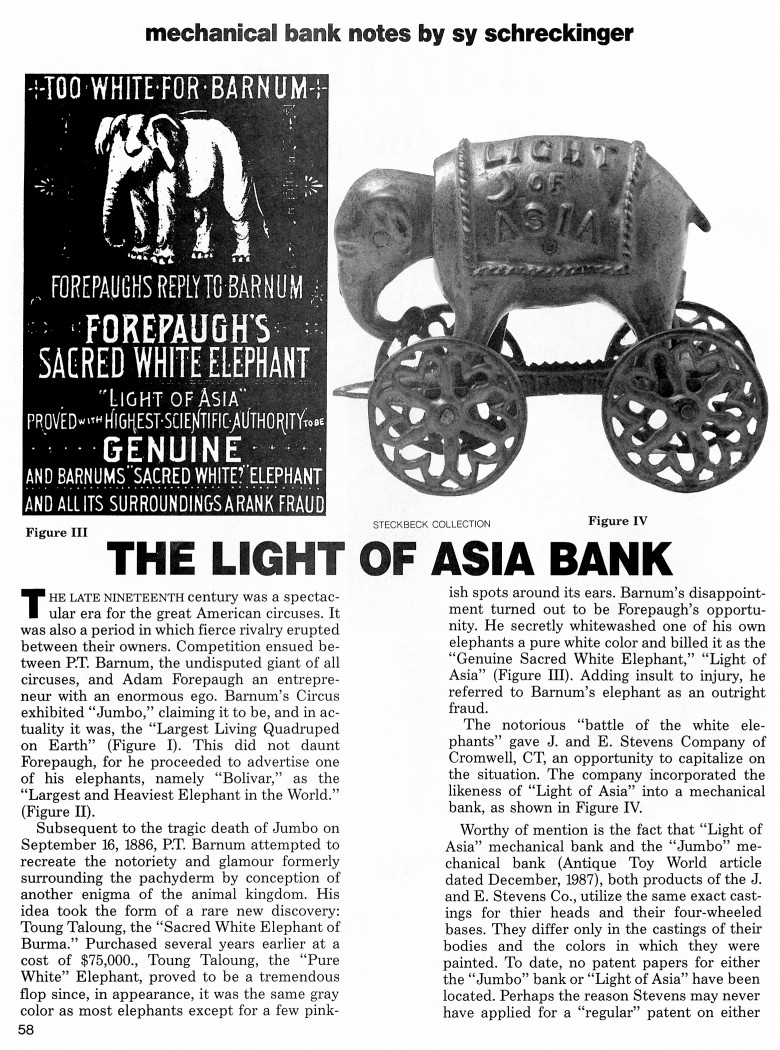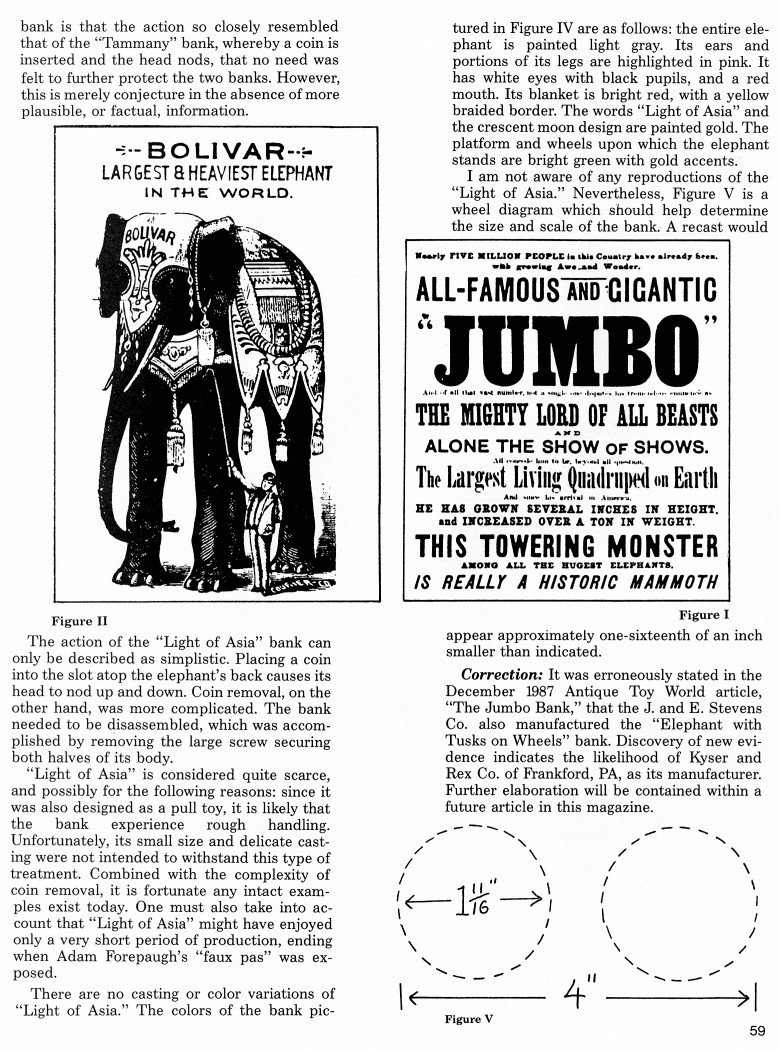|
The Light of Asia Bank
by Sy Schreckinger – ANTIQUE TOY WORLD Magazine – November,
1991
The late nineteenth century was a spectacular
era for the great American circuses. It was also a period in which fierce
rivalry erupted between their owners. Competition ensued between P.T.
Barnum, the undisputed giant of all circuses, and Adam Forepaugh an
entrepreneur with an enormous ego. Barnum's Circus exhibited "Jumbo,"
claiming it to be, and in actuality it was, the "Largest Living Quadruped
on Earth" (Figure I). This did not daunt Forepaugh, for he proceeded to
advertise one of his elephants, namely "Bolivar," as the "Largest and
Heaviest Elephant in the World." (Figure II).
Subsequent to the tragic death of Jumbo on September 16, 1886, P.T.
Barnum attempted to recreate the notoriety and glamour formerly
surrounding the pachyderm by conception of another enigma of the animal
kingdom. His idea took the form of a rare new discovery: Toung Taloung,
the "Sacred White Elephant of Burma." Purchased several years earlier at a
cost of $75,000., Toung Taloung, the "Pure White" Elephant, proved to be a
tremendous flop since, in appearance, it was the same gray color as most
elephants except for a few pinkish spots around its ears. Barnum's
disappointment turned out to be Forepaugh's opportunity. He secretly
whitewashed one of his own elephants a pure white color and billed it as
the "Genuine Sacred White Elephant," "Light of Asia" (Figure III). Adding
insult to injury, he referred to Barnum's elephant as an outright fraud.
The notorious "battle of the white elephants" gave J. and E. Stevens
Company of Cromwell, CT, an opportunity to capitalize on the situation.
The company incorporated the likeness of "Light of Asia" into a mechanical
bank, as shown in Figure IV.
Worthy of mention is the fact that "Light of Asia" mechanical bank
and the "Jumbo" mechanical bank (Antique Toy World article dated
December, 1987), both products of the J. and E. Stevens Co., utilize the
same exact castings for their heads and their four-wheeled bases. They
differ only in the castings of their bodies and the colors in which they
were painted. To date, no patent papers for either the "Jumbo" bank or
"Light of Asia" have been located. Perhaps the reason Stevens may never
have applied for a "regular" patent on either bank is that the action so
closely resembled that of the "Tammany" bank, whereby a coin is inserted
and the head nods, that no need was felt to further protect the two banks.
However, this is merely conjecture in the absence of more plausible, or
factual, information.
The action of the "Light of Asia" bank can only be described as
simplistic. Placing a coin into the slot atop the elephant's back causes
its head to nod up and down. Coin removal, on the other hand, was more
complicated. The bank needed to be disassembled, which was accomplished by
removing the large screw securing both halves of its body.
"Light of Asia" is considered quite scarce, and possibly for the
following reasons: since it was also designed as a pull toy, it is likely
that the bank experience rough handling. Unfortunately, its small size and
delicate casting were not intended to withstand this type of treatment.
Combined with the complexity of coin removal, it is fortunate any intact
examples exist today. One must also take into account that "Light of
Asia" might have enjoyed only a very short period of production, ending
when Adam Forepaugh's "faux pas" was exposed.
There are no casting or color variations of "Light of Asia." The
colors of the bank pictured in Figure IV are as follows: the entire
elephant is painted light gray. Its ears and portions of its legs are
highlighted in pink. It has white eyes with black pupils, and a red mouth.
Its blanket is bright red, with a yellow braided border. The words "Light
of Asia" and the crescent moon design are painted gold. The platform and
wheels upon which the elephant stands are bright green with gold accents.
I am not aware of any reproductions of the "Light of Asia."
Nevertheless, Figure V is a wheel diagram which should help determine the
size and scale of the bank. A recast would appear approximately
one-sixteenth of an inch smaller than indicated.
Correction: It was erroneously stated in the
December 1987 Antique
Toy World article, "The Jumbo Bank," that the J. and E. Stevens Co. also
manufactured the "Elephant with Tusks on Wheels" bank. Discovery of new
evidence indicates the likelihood of Kyser and Rex Co. of Frankford, PA,
as its manufacturer. Further elaboration will be contained within a future
article in this magazine.
|


